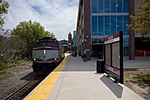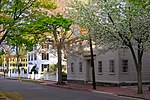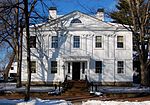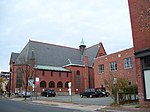Salem station is an MBTA Commuter Rail station served by the Newburyport/Rockport Line. The station is located off Bridge Street (Route 107) near its interchange with North Street (Route 114) at the north end of downtown Salem, Massachusetts. The station has a single accessible full-length high-level platform serving the single track of the Eastern Route. Just south of the station is the Salem Tunnel, which carries the line under Washington Street. Salem is a major park and ride center, with a 700-space parking garage, as well as an MBTA bus terminal. It is the busiest commuter rail station in the MBTA system outside of the central Boston stations, with an average of 2,326 daily boardings in a 2018 count.
The Eastern Railroad opened between Salem and East Boston in August 1838. The first passenger accommodations were a ticket office and waiting room inside a warehouse; a wooden station was soon built. An extension to Ipswich (including the Salem Tunnel) and a branch to Marblehead opened in December 1839. In December 1847, the railroad opened a massive castle-like stone station designed by Gridley James Fox Bryant. The opening of the Essex Railroad in 1847, followed by the South Reading Branch Railroad and the Salem and Lowell Railroad in 1850, made Salem a major railroad junction. A yard with a roundhouse and coaling tower was built in the wye between the Eastern and the Essex. The Boston and Maine Railroad (B&M) controlled the Eastern and the other lines meeting at Salem by 1887.
In the late 1940s, the B&M and the state began a three-part project to eliminate grade crossings in the downtown area. Overpasses for Bridge Street and North Street, the former acting as an extension of the tunnel, were completed in the early 1950s. The B&M began demolition of the station in October 1954 to make way for a southward expansion of the tunnel to eliminate the last two grade crossings. The extended tunnel opened in August 1958 along with a new station, which had platforms in the trench south of the tunnel and a brick station building at street level. Service on the branch lines connecting to Salem declined in the 20th century, with the final branch service to Marblehead ending in 1959. In January 1965, the 1964-formed Massachusetts Bay Transportation Authority (MBTA) began subsidizing some B&M suburban service, including the Eastern Route.
After a fire destroyed the bridge to Beverly in November 1984, the former rail yard at the north end of the tunnel was used as a temporary station to connect to buses, which replaced the northern branches of the line until December 1985. In August 1987, as part of a larger project to improve the line, the MBTA opened an accessible permanent station at the site, replacing the non-accessible station to the south. After years of planning, construction of the parking garage and new platform began in June 2013. The garage and part of the platform opened in October 2014, with construction continuing into 2015. Proposals by the MBTA and the city of Peabody have called for passenger service to be restored from Salem to Peabody and Danvers.












